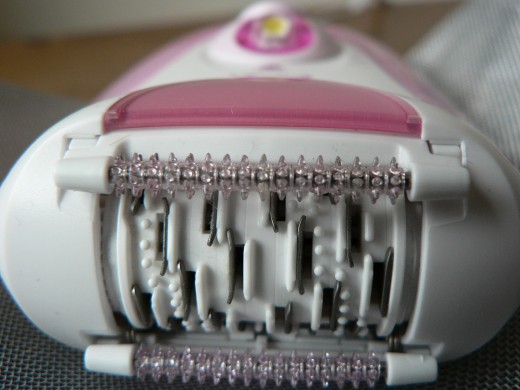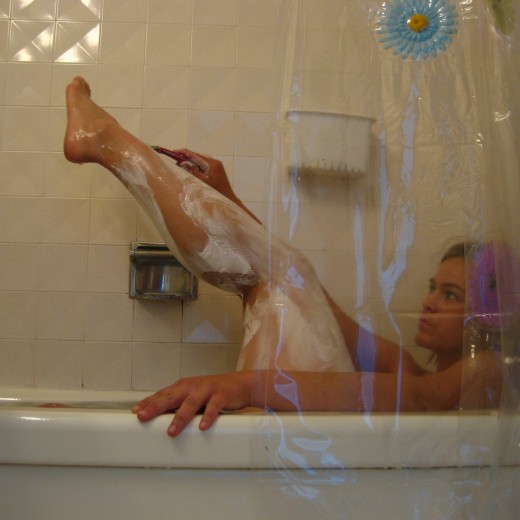Why Western women started to remove their body hair in the early 20th century - and why some are deciding to stop

I am envious of American women (and their European sisters) in the beginning of the 20th century for one reason - for the majority of them body hair was a non-issue and the practice of removing hair from armpits and legs was not a widespread behaviour. Yet, hairless body was to become the accepted beauty norm, with a host of other practices including dieting and the regular use of make-up also believed to enhance the body. Women's magazines, advertising and fashion played a role in determining what the ideal female body should look like, as Kirsten Hansen details in her thesis "Hair or Bare?: The History of American Women and Hair Removal, 1914-1934".
It seems that any woman today who doesn't get rid of her 'superfluous' hair is bound to shock others. Nonetheless, a growing number of women are making that choice. There are many legitimate reasons not to participate, and women should have the right to make decisions about their own bodies based on personal preferences whatever the cultural norm.
Changing attitudes to body hair
Hair removal product marketing (the advertising I've sampled in any case) would have you believe that body hair has always been considered ugly and that it's a basic human, and especially female, need to remove it for aesthetic purposes. It's true that throughout the times women in many cultures have been more inclined to remove hair from their bodies than men. However, the historical reasons are varied and seem to not always revolve around beauty standards. There have been other motives for the custom, such as parasite prevention, class symbolism and religion. It's notable also that there has not necessarily been a gender divide in this behaviour - in many instances it has been a culturally specific practice. In ancient Egypt and India, for example, both men and women removed hair from their bodies.
European women paid little attention to hair removal in the Middle Ages (as did men to shaving) and even less so when the queen of France in the 1500s, Catherine de Medici, strongly opposed to it. Because the majority of the women colonising America were of Caucasian European origin, American women weren't engaging in body hair removal either. But since it wasn't customary for American women of the early 20th century to remove their body hair - and the practice is reportedly the most hated beauty ritual of women today - who then decided, and when, that body hair was 'undesirable' and, specifically, 'unfeminine' as the consensus is today?
'Objectionable' hair and the untapped female market
Although some sporadic adverts promoting homemade hair removal products for the face and the forearms had already been featured in magazines, 1915 is when large companies took notice of the unexploited market of female hair removal and began to target underarm hair. A depilatory powder called X Bazin was featured in the upper class women's magazine Harper's Bazaar, explaining the need to have smooth underarms because of tango (the dance fad of the time) and the corresponding fashion of sleeveless gowns. K. C. Gillette, who had become rich by inventing a disposable razor for men, in turn sought to expand the market for his products and launched Milady Décolleté Gillette. A boom of new products and advertising followed as more than a dozen beauty care companies got a whiff of new profits and began to promote their own products in Harper's Bazaar. Advertising repeatedly told women that hair in the armpit was 'unsightly', 'unhygienic', 'unwelcome' and 'embarrassing', whereas smooth underarms were 'alluring', 'exquisite', 'sanitary', 'clean' and 'feminine'. Upper class women were convinced by these messages and didn't take long to adopt the habit of underarm hair removal.
Leg hair must go
Leg hair was the next target on the line, as companies sought to expand even further the profits from the female hair removal market. Again, as advertisers used the rapidly rising hem line of women's fashion as their justification for labelling their products a compulsory part of women's lives, women were now hearing the message that leg hair, too, should be non-existent on any self-respecting woman. In the beginning the campaign was hindered by stockings that were in style at the time. It was also more subtle than the 'underarm campaign' - smooth legs were increasingly on show in adverts from 1918, but leg hair was rarely specifically targeted. Eventually the message got through, however, and women added leg hair removal into their beauty routine.

No excuse for a single hair
Middle class women who liked to emulate the upper class adopted both the more revealing clothing and the hair removal fashion that the trendsetting readers of Harper's Bazaar had first embraced. By the mid 1930s hair removal was evidently a normative behaviour not only among the elite but the middle classes as well. Today, some hundred years later, there is pressure on women not only to have smooth armpits and legs, but to make sure we get rid of our pubic hair too - or at the very least trim the bikini line. The words of a 1922 advert "there is no excuse for your having a single hair where it should not be" once promoted a new behaviour to women, but those same words now describe a reality that only a few question. Today's young women who start showing signs of maturity at puberty are not asking Should I get rid of my body hair? but What is the best method? The options for the latter are rather impressive - ranging from wet shaving to electric shaving, depilatories, waxing, epilators, electrolysis and even laser treatment - but it seems that the only option we don't have is not taking part.
Reclaiming our right to choose?
Hairless body has not always been the norm, or a prerequisite for being 'feminine'. Furthermore, with so much pressure to conform on the grounds of beauty alone, I think it's time to balance the discussion with the consideration of other aspects of women's well-being. Any reason should be an equally respectable basis for a woman's decision to remove body hair or not. To this end, I compiled a list of possible pros and cons of hair removal. As we all have different values and priorities, not all of these points will apply to every woman. Neither will they apply to every method of hair removal.

The Pros of Body Hair Removal
1. You get to be normal. Normal, that is, in the sense of fitting in and conforming to the prevailing beauty norm. Approximately 9 out of 10 Western women now remove their body hair. You don't need to justify your choice to remove your body hair as you're in the majority and need not fear judgement. No one will call you 'gross' on the grounds of having hair on your body. This is why many women who otherwise consider hair removal unnecessary, say that they take part nonetheless.
2. Preference. Some women say they prefer the aesthetic and tactile qualities of artificially smoothed skin over natural hairy skin. They should certainly be able to do as they wish.
The Cons of Body Hair Removal
1. The pain. My memories of leg and armpit shaving include painful cuts and bleeding. I don't know about the pain of other methods like waxing or epilators, but apparently you get used to it. Not surprisingly though, one of the regularly used selling points of some hair removal methods is that they are either pain free or less painful than other methods.
2. Health risks. Despite the commercial success of the hair removal industry, there is not yet a product on the market that is perfectly safe to use. Users of depilatory have reported chemical burns, rashes, blisters and skin peeling as side effects. Shaving can cause cuts, skin irritation, inflammation and infections. Waxing can cause skin irritation, burns and bruising. Side effects of using an epilator may include irritation and rashes, and those of laser hair removal include swelling, numbness and itching of the treated area as well as scarring, hyper pigmentation, burns and infected wounds. Electrolysis poses the risks of infection and scarring.

Hair removal from the pubic area and armpits have other, potentially more serious, problems. A study conducted in 2013 reported an increased risk of contracting various STDs, especially Molluscum contagiosum, for women who shave or wax their pubic hair. This is due to the microscopic open wounds caused by shaving or waxing the pubic area offering an entry point for viruses and bacteria. Another study reports that armpit shaving may increase breast cancer risk for women who also use anti-perspirants. The researchers concluded that a shaven skin absorbs chemicals (such as parabens used as preservatives in anti-perspirants and found in breast tumours) more readily than skin that is intact.
3. The cost. One study in 2013 claimed that an average British woman spends about £8,000 over her lifetime on various hair removal products, while a 2008 survey stated that the figure for the average American woman is over $10,000, with a depilatory user spending a slightly higher sum of $10,555 and a woman who chooses waxing reported to spend as much as $23,000. Laser treatment can save a woman money in the long term, but may require her to fork out about $500 in the US or about £300 in the UK for a session depending on the body area targeted. The total cost can be much higher if several repeat treatments are needed.
4.The time. According to the surveys mentioned above, British women spend about 4 months of their lifetime removing body hair, while their American sisters engage in the activity for roughly 2 months over the years. Interestingly, a majority of women questioned in the British study also confessed to going into great lengths to not let their partners know just how much time they invest in being hairless.
5. Environmental effects. The effects on the environment vary depending on the product and the method of hair removal chosen. In the US an estimated 2 billion disposable razors are dumped into landfills every year, while each American woman who leaves the tap or shower running while she shaves uses an amount of water equivalent to slightly less than an Olympic-size swimming pool during her lifetime. Epilators and electric razors need electricity that comes either from the mains or from batteries. Furthermore there's packaging (often plastic) and transportation of the products. Laser hair removal, that may seem like a good alternative because of its long-lasting effects, has now been shown to release harmful chemical compounds into the air.

7. Limiting choices? As long as the vast majority of women keep their bodies clean shaven (waxed, etc.) at all times, the option of not removing body hair has little chance of becoming an acceptable and equal choice for women in general. On the contrary, if more women opted for keeping their body in its natural state, even for some of the time, then perhaps it would eventually became a complete non-issue whether we have body hair or not - just as it isn't shocking anymore for a woman to wear trousers instead of a skirt.
A new movement
Some women have began to embrace their bodies as they are, and are supporting each other in making a choice that goes against the prevalent cultural norm. They are now asking 'why' instead of 'how' regarding body hair removal, and with the list of negatives that go with it, they should have every right to do so. Supportive places for these women on the internet include the Hairy Legs Club on tumblr and WANG (Women Against Non-essential Grooming) on Facebook. Women share photos of their armpits and legs as well as their thoughts on going au naturel. Even a few models and celebrities - arguably the least likely to divert from accepted beauty standards - are openly opting for naturally fuzzy armpits and legs. Perhaps the time will come when all of us can make that choice without fear of criticism. Here's hoping.









